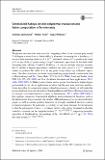| dc.contributor.author | Björklund, Andreas | |
| dc.contributor.author | Kaski, Petteri | |
| dc.contributor.author | Williams, Richard Ryan | |
| dc.date.accessioned | 2018-10-01T13:56:55Z | |
| dc.date.available | 2018-10-01T13:56:55Z | |
| dc.date.issued | 2018-09 | |
| dc.date.submitted | 2017-12 | |
| dc.identifier.issn | 0178-4617 | |
| dc.identifier.issn | 1432-0541 | |
| dc.identifier.uri | http://hdl.handle.net/1721.1/118295 | |
| dc.description.abstract | We present two new data structures for computing values of an n-variate polynomial P of degree at most d over a finite field of q elements. Assuming that d divides q − 1, our first data structure relies on (d + 1)[superscript n+2] tabulated values of P to produce the value of P at any of the q[superscript n] points using O(nqd[superscript 2]) arithmetic operations in the finite field.
Assuming that s divides d and d/s divides q − 1, our second data structure assumes that P satisfies a degree-separability condition and relies on (d/s + 1)[superscript n+s] tabulated values to produce the value of P at any point using O(nq[superscript s]sq) arithmetic operations. Our data structures are based on generalizing upper-bound constructions due to Mockenhaupt and Tao (Duke Math J 121(1):35–74, 2004), Saraf and Sudan (Anal PDE 1(3):375–379, 2008) and Dvir (Incidence theorems and their applications, 2012. arXiv:1208.5073) for Kakeya sets in finite vector spaces from linear to higher-degree polynomial curves. As an application we show that the new data structures enable a faster algorithm for computing integer-valued fermionants, a family of self-reducible polynomial functions introduced by Chandrasekharan and Wiese (Partition functions of strongly correlated electron systems as fermionants, 2011. arXiv:1108.2461v1) that captures numerous fundamental algebraic and combinatorial functions such as the determinant, the permanent, the number of Hamiltonian cycles in a directed multigraph, as well as certain partition functions of strongly correlated electron systems in statistical physics. In particular, a corollary of our main theorem for fermionants is that the permanent of an m × m integer matrix with entries bounded in absolute value by a constant can be computed in time 2[superscript m−(√m/ log log m)], improving an earlier algorithm of Björklund (in: Proceedings of the 15th SWAT, vol 17, pp 1–11, 2016) that runs in time 2[superscript m−(√m/ log m)]. | en_US |
| dc.description.sponsorship | National Science Foundation (U.S.) (Grant CCF-1741638) | en_US |
| dc.description.sponsorship | National Science Foundation (U.S.) (Grant CCF-1741615) | en_US |
| dc.publisher | Springer US | en_US |
| dc.relation.isversionof | https://doi.org/10.1007/s00453-018-0513-7 | en_US |
| dc.rights | Creative Commons Attribution | en_US |
| dc.rights.uri | http://creativecommons.org/licenses/by/4.0/ | en_US |
| dc.source | Springer US | en_US |
| dc.title | Generalized Kakeya sets for polynomial evaluation and faster computation of fermionants | en_US |
| dc.type | Article | en_US |
| dc.identifier.citation | Björklund, Andreas, et al. “Generalized Kakeya Sets for Polynomial Evaluation and Faster Computation of Fermionants.” Algorithmica, Sept. 2018. © 2018 The Authors | en_US |
| dc.contributor.department | Massachusetts Institute of Technology. Department of Electrical Engineering and Computer Science | en_US |
| dc.contributor.mitauthor | Williams, Richard Ryan | |
| dc.relation.journal | Algorithmica | en_US |
| dc.eprint.version | Final published version | en_US |
| dc.type.uri | http://purl.org/eprint/type/JournalArticle | en_US |
| eprint.status | http://purl.org/eprint/status/PeerReviewed | en_US |
| dc.date.updated | 2018-09-19T03:55:13Z | |
| dc.language.rfc3066 | en | |
| dc.rights.holder | The Author(s) | |
| dspace.orderedauthors | Björklund, Andreas; Kaski, Petteri; Williams, Ryan | en_US |
| dspace.embargo.terms | N | en_US |
| dc.identifier.orcid | https://orcid.org/0000-0003-2326-2233 | |
| mit.license | PUBLISHER_CC | en_US |
